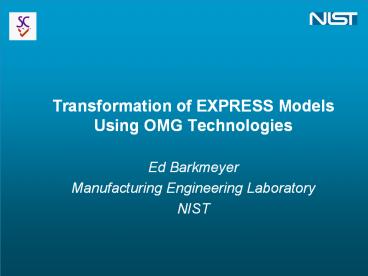Transformation of EXPRESS Models Using OMG Technologies
1 / 37
Title:
Transformation of EXPRESS Models Using OMG Technologies
Description:
Transformation of EXPRESS Models. Using OMG Technologies. Ed Barkmeyer ... Initializer Expressions. Instances. Simple Values. Aggregate Values. Entity Values ... –
Number of Views:31
Avg rating:3.0/5.0
Title: Transformation of EXPRESS Models Using OMG Technologies
1
Transformation of EXPRESS ModelsUsing OMG
Technologies
- Ed Barkmeyer
- Manufacturing Engineering Laboratory
- NIST
2
Outline
- What is EXPRESS?
- Approach to EXPRESS Migration
- The EXPRESS Metamodel
- Next steps
3
What is EXPRESS
- EXPRESS
- an information modeling language
- developed in the late 1980s
- standardized as ISO 10303-111994, revisions
1999, 2004 - Used in manufacturing data exchange standards
- ISO 10303 (STEP) 200 data schemas
- ISO 13584 (PLIB) 50 data schemas
- ISO 15531 (MANDATE), 15926, 18876, etc.
4
Features of EXPRESS
- Entity definitions
- somewhere between Class and Record
- attributes with data types, multiplicities
- inverse and derived attributes
- subtypes
- keys (UNIQUE rules)
- Type definitions
- basic types Integer, Real, Boolean, String, etc.
- aggregations ARRAY, BAG, LIST, SET
- (extensible) ENUMERATION
- SELECT (choice, union)
5
Rules in EXPRESS
- Local rules
- allowable values for Types
- allowable values for attributes, inter-attribute
relationships - Global rules
- relationships of extents of entity types
- subtype relationships exclusion, covering,
overlap, equivalence - Rules defined by expressions
- Function definitions
6
TC184/SC4 Approach
- Model-Driven Architecture vintage 1985
- data models, separate from implementation
- mappings to specific implementation languages
- common conceptual schema for product models
developed area by area - application-specific (i.e. usage-specific) views
- Enablers
- EXPRESS language ISO 10303-111994
- clear-text encoding ISO 10303-211994
- APIs mappings to C, CORBA IDL, Java
- XML encoding (2003), XMI encoding (2004)
7
Reasons for Migration
- Much engineering knowledge captured in 200
standard EXPRESS models - Not accessible to most software experts
- EXPRESS is an uncommon language
- Not easily translated to new technologies
- platform-independent, platform-class
dependentRelational database modeling style - Need
- neutral form of knowledge
- formal translation languages
MOF
8
Approach
- MOF metamodel of EXPRESS
- MOF QVT transform to UML v2 metamodel
- EXPRESS schemas to UML OCL models
- ISO 10303-25 v2, OMG RFC
- MOF QVT transform to Ontology Definition
Metamodel - EXPRESS schemas to OWL models
- EXPRESS rules modeled in ISO Common Logic
- OMG RFP or RFC
- Open Source implementations
9
EXPRESS v2 Metamodel
- draft 24 May 2005
10
Packages
Schemas
Language
Instances
Rules
Types
Algorithms
Expressions
Constants
11
Meta-types for the EXPRESS Language
12
Named Elements
13
Scopes
14
Naming
15
Schemas
16
EXPRESS Types
DataType
ParameterType
(disjoint, total)
(disjoint, total)
InstantiableType
GeneralizedType
PartialEntityType
(disjoint, total)
(disjoint, total)
AnonymousType
EntityType
NamedType
isAbstract
Boolean
id
ScopedId
17
Instantiable Types
18
Simple Types
19
Aggregation Types
20
Generalized Types
21
Entity Types
22
Attributes
23
Type Scopes and Naming
24
Algorithms
25
Rules
26
Constants
27
Expressions
28
Full Expression
29
Reference Expressions
30
Function calls
31
Initializer Expressions
32
Instances
33
Simple Values
34
Aggregate Values
35
Entity Values
36
Next Steps
- Verify/correct EXPRESS metamodel
- with ISO EXPRESS experts
- Develop mapping to ODM
- entities/types to OWL,
- rules to ISO Common Logic
- Develop mapping to UML v2 metamodel
- entities and types to class diagram elements
- rules to OCL elements
37
Next Steps (continued)
- Build EXPRESS parser add-ons
- to produce XMI for EXPRESS metamodel
- Use MOF/QVT tools to implement mappings
- Propose ODM mappings to OMG
- OMG RFC? RFP?
- Propose UML mappings to ISO
- revision of ISO 10303-25
- OMG RFC after successful ISO ballot































